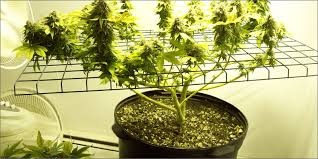ScrOG and SoG Techniques: Key Differences, Pros, and Cons
In this article, we’ll look at the main differences and core features of two popular indoor growing techniques: ScrOG (Screen of Green) and SoG (Sea of Green). We’ll also discuss the advantages and disadvantages of each method.
1. ScrOG (Screen of Green)
ScrOG stands for “Screen of Green.” This technique uses a mesh or screen, which you can make yourself from slats and string, buy pre-made, or cut from a piece of wire fencing or plastic garden netting. I personally use a plastic garden net with 4×4 cm (about 1.5×1.5 inch) openings. The screen should fit the size of your grow box.
ScrOG is especially useful when you have limited vertical space, as the screen restricts the plant’s upward growth. With this method, you top the plants, which encourages branching. Instead of one main cola, you get a bushy plant with many shoots. The goal is to increase yield by promoting horizontal growth and creating more flowering sites. ScrOG also helps you maximize your grow area and use your lighting more efficiently.
I usually install the screen during the 3rd or 4th week of vegetative growth. Carefully bend the main stem down to the soil and secure it under the screen. Any shoots that grow above the screen should also be gently trained back under it. Repeat this process as needed until the plant stops growing. By the end of flowering, you’ll have a “green carpet” of buds.
Notes:
- Pruning can be done in the second week. I covered pruning methods in a previous article.
- It’s best to combine ScrOG with LST (low-stress training) for optimal results.
- If you accidentally break a branch or stem but it’s not completely severed, don’t panic. Carefully align the broken parts and tape them together with a bandage or electrical tape. If needed, support the branch with a stake or tie it to the ceiling and leave it alone. It should heal. Some growers intentionally “supercrop” branches during flowering to boost yields, but I haven’t tried this myself. However, I’ve had branches and stems break and heal successfully, resulting in good harvests.
2. SoG (Sea of Green)
SoG stands for “Sea of Green.” This method is focused on maximizing the use of your grow space. Plant density is much higher than with ScrOG. In SoG, you use clones—cuttings that have already started to root—so they mature faster. Clones are switched to flowering quickly, sometimes just a few days after being placed in the system, and you can harvest a decent yield in 2-3 months.
With SoG, you can fit up to 40 plants per square meter (about 10.7 square feet) and harvest a bit earlier than with traditional methods. While cloning saves you money on seeds, you’ll need space for seedlings, and you’ll spend time and resources maintaining a mother plant, cloning, rooting cuttings, and caring for the clones (lighting, nutrients, watering). It’s a bit of a hassle, but it can be very rewarding.



